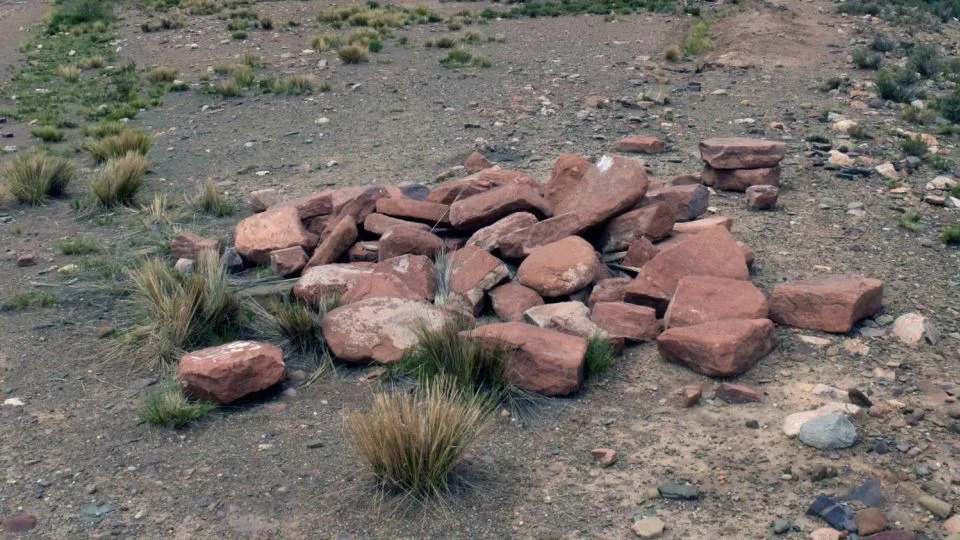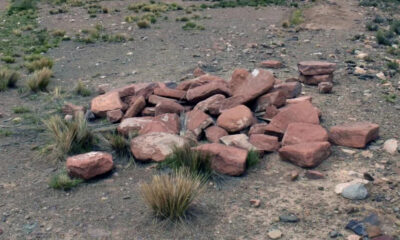Science
Archaeologists Uncover Ancient Tiwanaku Temple in Bolivia

Archaeologists have discovered the ruins of what is believed to be an ancient temple associated with the enigmatic Andean society of Tiwanaku, which vanished around AD 1000. This significant find was made in the highlands of present-day Bolivia, specifically in the municipality of Caracollo, southeast of Lake Titicaca. The site, known as Palaspata, is located approximately 130 miles (about 210 kilometers) south of the well-known archaeological site of Tiwanaku, the capital of the empire that preceded the Incas.
The remarkable discovery was detailed in a study published on June 24, 2023, in the journal Antiquity. The lead author, Dr. José Capriles, a Bolivian archaeologist and associate professor of anthropology at Pennsylvania State University, noted that the temple’s architectural features, including a terraced platform and sunken courtyard, closely resemble those found in other Tiwanaku sites around Lake Titicaca.
Significance of the Palaspata Temple
The newly uncovered temple, which has a pathway running through it due to frequent local travel, is strategically located near a major Bolivian travel route known as the La Paz–Cochabamba Highway. This highway historically connected several trade routes used by subsequent societies, including the Incas. Researchers suggest that the discovery of this ceremonial temple may illuminate the interconnectedness of the various territories of the Tiwanaku society and how Palaspata potentially acted as a gateway for the expansion of Tiwanaku’s influence in the region.
Despite archaeological investigations of Tiwanaku sites beginning in the 1860s, much about this society remains elusive. Most knowledge has been gleaned from the study of ceramics, camelid remains, and other religious sites, such as Akapana. Tiwanaku communities initially emerged in the Titicaca Basin, an altiplano area in the Andes. Given the challenging farming conditions, the society relied on llama caravans to facilitate trade and connection among communities.
Dr. Capriles emphasized the complexity of the Tiwanaku civilization, describing it as a “primary state formation” with advanced social stratification. According to the study, the Tiwanaku empire developed independently, emerging from earlier agricultural societies around AD 700. Dr. Nicola O’Connor Sharratt, an associate professor of anthropology at Georgia State University, who was not involved in the study, noted that Tiwanaku populations likely extended beyond their known territories into areas now recognized as northern Chile and Cochabamba.
Exploring the Architectural Features and Cultural Practices
The Palaspata temple is primarily identifiable by its perimeter wall, constructed from red sandstone. Initial recognition of the structure occurred while researchers were engaged in an unrelated project near the highway. Observing its potential significance, they conducted further investigations on foot and with drones. Utilizing 3D rendering techniques, Dr. Capriles created a digital reconstruction of the temple, revealing that it measures 125 meters long and 145 meters wide (approximately 410 by 475 feet), comparable in size to a city block. The temple features 15 modular enclosures likely intended for various purposes surrounding an inner courtyard.
The main entrance of the building faces west, aligning with the solar equinox, which underscores its religious significance within the Tiwanaku society. While knowledge of their spiritual practices remains limited, previous excavations have uncovered stone monoliths and ceramics bearing symbolism linked to plants and animals, indicative of traditions seen in other pre-Inca cultures. Additionally, archaeologists have discovered Tiwanaku pottery at the site, including keru cups, which were typically used for consuming maize-based beverages during communal gatherings.
The Tiwanaku civilization remains one of the more enigmatic ancient societies, with researchers still piecing together its history. Theories regarding its decline often point to factors like drought or environmental degradation, potentially leading to social unrest and subsequent upheaval. Dr. Sharratt remarked that early archaeologists had difficulty reconciling Tiwanaku’s characteristics with their preconceived notions of what a successful state or thriving city should resemble.
As researchers continue to investigate the Palaspata site, they hope to gain deeper insights into the social, economic, and religious dynamics of the Tiwanaku civilization, further illuminating the lives and practices of this lost society.
-

 Technology5 months ago
Technology5 months agoDiscover the Top 10 Calorie Counting Apps of 2025
-

 Health3 months ago
Health3 months agoBella Hadid Shares Health Update After Treatment for Lyme Disease
-

 Health3 months ago
Health3 months agoErin Bates Shares Recovery Update Following Sepsis Complications
-

 Technology4 months ago
Technology4 months agoDiscover How to Reverse Image Search Using ChatGPT Effortlessly
-

 Technology1 month ago
Technology1 month agoDiscover 2025’s Top GPUs for Exceptional 4K Gaming Performance
-

 Technology3 months ago
Technology3 months agoElectric Moto Influencer Surronster Arrested in Tijuana
-

 Technology5 months ago
Technology5 months agoMeta Initiates $60B AI Data Center Expansion, Starting in Ohio
-

 Technology5 months ago
Technology5 months agoRecovering a Suspended TikTok Account: A Step-by-Step Guide
-

 Health4 months ago
Health4 months agoTested: Rab Firewall Mountain Jacket Survives Harsh Conditions
-

 Lifestyle5 months ago
Lifestyle5 months agoBelton Family Reunites After Daughter Survives Hill Country Floods
-

 Health3 months ago
Health3 months agoAnalysts Project Stronger Growth for Apple’s iPhone 17 Lineup
-

 Technology4 months ago
Technology4 months agoHarmonic Launches AI Chatbot App to Transform Mathematical Reasoning













